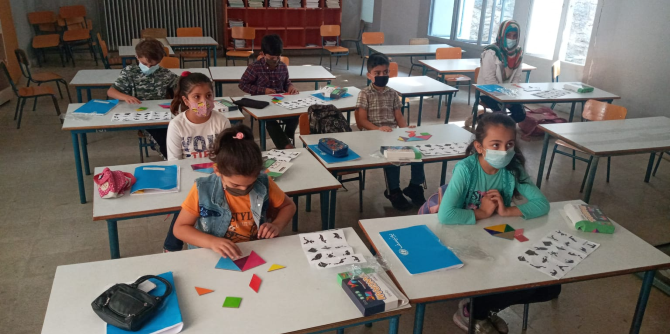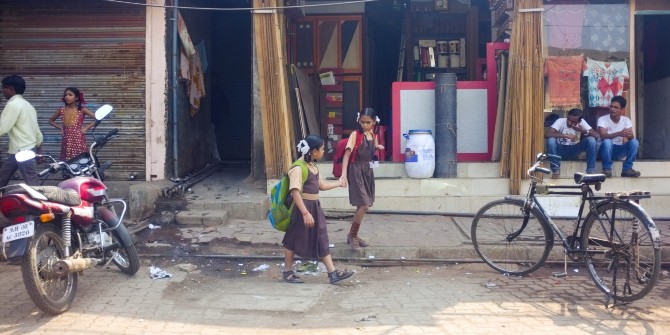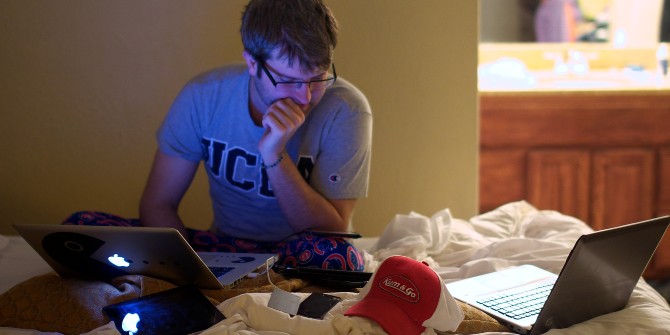Nearly all schools closed at some point during the pandemic. Reviewing the evidence so far, Jo Blanden (University of Surrey/CEP, LSE), Matthias Doepke (Northwestern) and Jan Stuhler (Universidad Carlos III de Madrid) warn that these closures will have a major negative impact on educational inequality.
Ninety-four percent of the world’s student population was affected by school and university closures in the spring of 2020, according to UNESCO. By May 2021, schools across countries had been fully closed for an average of 17 weeks. These closures varied widely in length, and were only partially determined by infection rates. Students in many developing nations, and in some US states, experienced closures that lasted more than a year — whereas there were no designated school closures at all in Belarus and Burundi. Closures were particularly long in China, Indonesia, and some countries in Southern Europe, but of similar intensity in most other countries.
School closures have been especially controversial in the US and Canada, where they have continued much longer than in other developed economies. In the US, closures were determined at the state or school district level, resulting in substantial variation in children’s experiences, as well as posing a challenge for the systematic collection of data. Evidence from mobile phone locations indicates that nine out of 10 schools were closed in April 2020, falling to 40 percent in September but then rising again to 56 percent in December of that year. Halloran et al. (2021) use school district-level data from 12 US states for the 2020–2021 academic year and show that shares of in-person schooling time varied from 9 percent in Virginia to 98 percent in Florida.
Learning losses, once incurred, are difficult to compensate for later
Learning is a cumulative process, where skills acquired at one life stage foster further learning later on. This means that learning losses, once incurred, are difficult to compensate for later. Many of the schoolchildren affected by the pandemic are therefore likely to enter adult life with fewer skills and lower educational attainment than they would have otherwise. This loss of what economists call ‘human capital’ will be reflected in lower lifetime earnings at the individual level, and could result in a lower stock of human capital and lower national income at the aggregate level for decades to come.
We are particularly interested in whether school closures increase educational inequality by differentially impacting children from different socio-economic backgrounds. There are two reasons why this might occur. First, the incidence of school closures themselves may vary by social background, for instance when public schools close while private schools attended by richer families stay open. Second, children from disadvantaged backgrounds might experience greater learning loss if their school closes. Children’s learning depends on inputs from educational institutions, parental inputs, and neighbourhood and peer effects. The potential for other inputs to compensate when schools are closed is likely to differ across families.
During the closures, the inputs provided by schools and teachers were often delivered via online education. Yet just how well virtual education can replace in-person schooling depends on factors such as having a reliable internet connection, functioning tablets or laptops, and a quiet work environment, all of which are more likely to be met in higher-income families. Parents also play an important role, and richer parents may not only be more capable of assisting their children in making up for lost time but also more likely to work from home, so they can help if need be.
School closures are not the only mechanism through which the pandemic may impact educational inequality. Its macroeconomic effects could decrease parents’ income and educational investments, reduce public spending on schooling, or affect the returns and incentives to acquiring education. The full impact of all of these changes on educational inequality will gradually emerge over the next few years, but researchers are already offering predictions based on several sources; from pre-pandemic evidence on the consequences of school closures, from early evidence from the pandemic, and from structural modelling of its long-run impact.
School closures in the US in the autumn of 2020 were more common for students from ethnic minorities
The pre-pandemic evidence suggests that COVID could increase educational inequality via two channels: a greater incidence of school closures in low-income neighbourhoods, and a greater learning loss conditional on closure among disadvantaged students. Indeed, early work on the pandemic supports both channels. Parolin and Lee (2021) show that school closures in the US in the autumn of 2020 were more common for students from ethnic minorities. School closures were also more widespread in institutions with lower third grade math scores, more homeless students, more students with limited English proficiency, and a larger share of students eligible for free or subsidised lunch. Halloran et al. (2021) confirm this picture, documenting that districts with a greater share of black students and a higher share of students receiving free lunches offered less in-person schooling.
In the UK, school closures are determined at the national level, but local mitigation procedures led to varying incidence, as groups of children were required to isolate if a positive case was detected in their “bubble.” Eyles and Elliot Major (2021) show that in autumn 2020, these localised measures led to nine days of missed schooling in the poorest areas compared to only two days in the most affluent municipalities. This evidence suggests that variation in the incidence of school closures could exacerbate educational inequalities.
Some alarming direct evidence is emerging on the impact of school closures in the early phases of the pandemic. Engzell, Frey, and Verhagen (2021) find that in the Netherlands, eight weeks of online rather than in-person learning led to 0.08 of a standard deviation lower test scores for students aged eight to 11. The impact is 40 percent larger among those in the least educated homes, suggesting that the pandemic not only increased educational inequality, but that disadvantaged children’s skills actually deteriorated. Tomasik, Helbling, and Moser (2021) analyse improvement in student skills in German-speaking Switzerland over the initial eight-week school closure starting in March 2020, compared to the eight weeks just prior. On average, primary school pupils learned half as much under distance learning, and there was more inequality in their progression. In particular, those with higher ability going into the pandemic saw stronger effects. Students in secondary school learned at the same speed as before.
Maldonado and De Witte (2020) provide evidence on 5th graders in Flemish Belgium who experienced seven weeks of school closure, partially replaced with online teaching. This period led to reduced test scores, equivalent to 0.19 of a standard deviation in maths and 0.29 of a standard deviation in Dutch compared to earlier cohorts. Students performed worse than if they had simply retained their initial knowledge, suggesting a slide in skills. The authors observe weak effects on inequality, with no differences across schools by initial average test scores or by the school’s social mix for math outcomes, and only slightly larger effects for poorer schools in Dutch.
These results suggest that school closures during the pandemic had greater effects on test scores than one might have expected based on extrapolations from prior evidence. Children’s learning may have been affected not just by the school closures themselves but also by other effects of the crisis, such as the disruption of peer interactions or increased anxiety during the pandemic. Improved virtual instruction might have helped reduce learning losses as the pandemic wore on, but uneven engagement has the potential to worsen inequalities even further. Lewis et al. (2021) point to “pandemic fatigue” as an explanation for why they observe more learning loss in the spring of 2021 compared to six months previously, and cite evidence that students were more likely to report not liking school in the winter of 2021 compared to the start of the academic year.
Halloran et al. (2021) show that proficiency rates in English and maths were on average 14 percentage points lower during the pandemic. By associating variation in time spent in different learning modes over the 2020/2021 academic year (remote, hybrid, in-person) with district-level information on test scores, the authors conclude that this gap would have only been four percentage points if schools had remained open throughout the period, though the effects are likely to be downward biased due to missing data. The authors see larger effects in districts with more students of colour and a greater number of students eligible for free school meals.
Underlying the impact of school closures on overall learning and educational inequality are several distinct mechanisms. First, the availability and quality of virtual learning offered by schools is clearly important. Second, there may be differences in parents’ ability to support virtual learning and to compensate for the lost investments from schools. Third, the work put in by the students themselves matters as well. Clark et al. (2021) consider evidence from China and show that children who have access to online learning through their school do 0.22 of a standard deviation better on tests that follow the end of a seven-week period of school closures. While effects by family background are not reported, the authors find that effective online learning is especially beneficial for low achievers. This observation suggests that inequalities in access to online learning may in part drive inequalities in the impact of school closure.
Andrew et al. (2020) survey parents in the first period of English school closures and find that primary school students in the tenth percentile of the family income distribution did about 35 minutes less learning per day than those from median-income families, and 1 hour and 10 minutes less that a child from a family in the 90th percentile of the income distribution. Similarly, Grewenig et al. (2021) and Werner and Woessmann (2021) find that during school closures, low-achieving students in Germany disproportionately replace learning time with less productive activities, such as playing video games.
School closures during the pandemic affect learning through three channels. First, there is a decline in the overall efficiency of skill accumulation because remote learning is less effective than in-person instruction. Second, parents have to replace some inputs that are usually provided by teachers. Parents’ ability to provide these inputs depends on time constraints: parents who are able to work from home during the pandemic have an easier time helping their children with school work than do essential workers who must work outside the home. Third, peer effects and peer-group formation is also disrupted during the pandemic.
Agostinelli et al. (2022) assess the contribution of these channels to educational inequality. All three channels are found to contribute to a widening of educational inequality. While all parents increase their time investments during the pandemic, the ability of low-income parents to respond is hampered by the fact they are much less likely to have jobs that can be done from home. Hence, inequality in parental input increases between high- and low-income neighbourhoods. Inequality in peer effects also rises, in part because children from low-income neighbourhoods lose the ability to meet more high-ability peers at school, and in part because the effect of losing any peer connection on learning is worse for children already struggling in school.
In the US, secondary and public schools were closed for longer periods than elementary and private schools, respectively. Fuchs-Schündeln et al. (2021) predict that the earnings- and welfare losses will be largest for children who started public secondary schools at the onset of the crisis. Welfare losses are smaller for children from richer families, who are more likely to send their children to private school. The authors further suggest that a policy intervention to extend schooling (by shortening the summer breaks in future years) would raise tax contributions sufficiently to be self-financing.

Survey evidence shows that considerably fewer children continued learning activities during school closures in low-income countries, with particularly large reductions in sub-Saharan Africa. Limited education funding and less access to communications technology implies that few children had access to virtual lessons during school closures. Many children essentially received no education at all during prolonged school closures, so that the total learning loss is likely to be severe. Moreover, beyond the size of the learning loss, a given learning loss is likely to have a greater long-run economic impact in low-income countries. This is partly due to demographic reasons. Low-income countries have much younger populations than do high-income countries, which means that cohorts of children finishing school are large compared to the adult labour force.
Commentators on both sides of the Atlantic have called for policy action to help offset the damaging effects of school closures. These primarily focus on what schools can do once children return. Proposed interventions include increased school funding, providing small group instruction, and lengthening the school day or year. All of these have potential, with targeted small group instruction shown to be especially fruitful. Evidence suggests that additional days spent at school raise test scores for poorer students, but the likelihood of diminishing returns means the optimal length of the post-pandemic school year is unclear.
It has already become clear that the pandemic has had a major negative impact on many children’s learning and is likely to have substantially increased educational inequality within the affected cohorts. Tracing the effect of this shock over the following years and contributing to the design of effective policy responses represents an important challenge for future research.
This post represents the views of the authors and not those of the COVID-19 blog, nor LSE. It is an edited extract from Education inequality: a Centre for Economic Performance discussion paper, by Jo Blanden, Matthias Doepke, and Jan Stuhler, April 2022.





